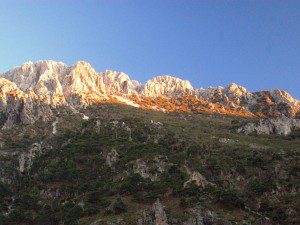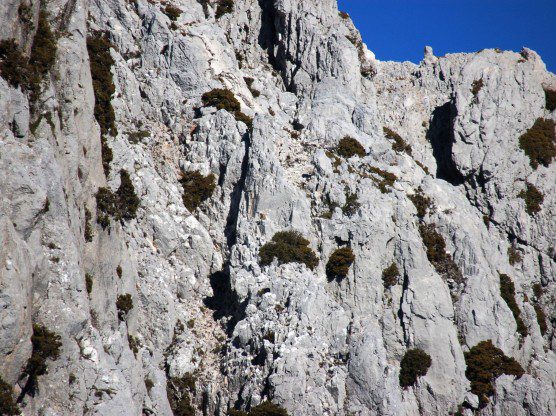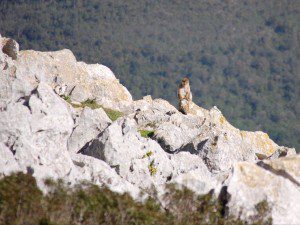The uncertain future of the Barbary macaque

Barbary macaques inhabit a variety of environments in their native Morocco, as our roving zoologist Keri Cairns discovered on his trip there earlier this year. From the squares of Marrakech to the roadsides of the Middle Atlas to the cork forests in the Rif Mountains; from sunny waterfalls to snowy paths. You can tell: these monkeys have learned how to survive. As long as humans don’t interfere too much.

Barbary macaques are amazingly adaptable primates.
Perhaps the most challenging natural environment where Keri encountered these macaques came on the last leg of his North African journey: the clusters of steep, white peaks known as the calcareous massif. The slopes of the mountain called Jebel Kelti sometimes rise so abruptly they hardly qualify as slopes at all. Yet, here is where Keri encountered the wildest macaques he had seen yet.

Part of Morocco’s calcareous massif; Barbary macaques make their home here, too.
Keri was introduced to this formation by his newfound friend, Ahmed El Harrad, deputy director of Barbary Macaque Conservation in the Rif (one of two groups in the region, along with the Moroccan Primate Conservation Foundation, that IPPL is helping to support). On his first morning hike, Keri reported, they came upon a small area of cork oak woodland. “We found fresh signs of Barbary macaque presence: scat, foraging traces, and even a footprint in the mud. Unfortunately, the macaques evaded us. Unlike the macaques I had been around elsewhere in the Atlas mountains, these are truly wild monkeys.”
Near the summit, they encountered goatherds and their dogs, but no monkeys. “Suddenly, Ahmed, with his eagle eyes, spotted one perched precariously on the side of a cliff. It was literally a tiny dot, and even through the zoom on my camera I could only see it when it moved. I then started to spot more, and we realized the whole group was there.

Spot the monkey in the dead center of this picture!
“In the late afternoon the goatherds started to move off the mountain. We waited as long as we could, but eventually we had to start back down before it got too dark. As you can probably guess, the macaques started to show up on the ridge of the hill, watching us leave. They finally had their mountain back to themselves!”
The next morning, Keri had an alarming vision of what could be the fate of Morocco’s macaques: a few remnant groups cut off from one another by rampant habitat destruction. The village of Boojmeel, just south of the massif’s Jebel Moussa, has macaques living nearby, and a helpful shepherd was able to point Keri to them within 10 minutes.
“Once again they were on a rock face, but as I was closer this time I was able to see that there was an abundance of plants and small grassy areas where the macaques could forage,” Keri reported. “It is amazing to see how agile and surefooted the macaques are, an essential skill if you live on a cliff!”

The Barbary macaques near the village of Boojmeel have been isolated from the rest of their species by habitat destruction.
Unfortunately, excessive quarrying in adjacent parts of the countryside means that these macaques have become completely isolated from their neighbors. “BMCRif has been carrying out education programs in the local school and is supporting the villagers in their fight to prevent the quarries moving into their area,” Keri told us.

Extensive quarrying in this part of Morocco has destroyed the landscape and isolated populations of macaques.
The final stop on Keri’s North African journey was at the base of Jebel Moussa. “It runs right down to the Mediterranean and is thought to be one of the legendary Pillars of Hercules, the other being the rock of Gibraltar,” said Keri.
“We parked up on a beach where I could see Gibraltar in the distance. Once again, Ahmed’s eagle eyes spotted a macaque on the cliff above us. He just seemed to be enjoying the view, perhaps looking across to Gibraltar and wondering how his cousins are getting on.”
A famous population of (non-native) Barbary macaques has made an uneasy living on Gibraltar for hundreds of years. Keri planned to check out their situation next.

